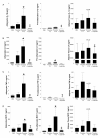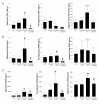Thrombin increases inflammatory cytokine and angiogenic growth factor secretion in human adipose cells in vitro
- PMID: 19267924
- PMCID: PMC2661073
- DOI: 10.1186/1476-9255-6-4
Thrombin increases inflammatory cytokine and angiogenic growth factor secretion in human adipose cells in vitro
Abstract
Background: Abdominal obesity is associated with pro-thrombotic and inflammatory states. Therefore, the purpose of this study was to examine the expression of thrombin receptors (PAR1 and PAR4) human adipose tissue and whether thrombin stimulates an inflammatory cytokine and growth factor profile in human adipose tissue.
Methods: Human adipose tissue, isolated preadipocytes and differentiated adipocytes were used in this study. PAR1 and PAR4 mRNA and protein were detected by RT-PCR and immunoblot analysis in both adipose tissue and adipose microvessels. In separate studies, IL-1beta, IL-6, MCP-1, TNF-alpha, IL-10, FGF-2, VEGF, and PDGF production were measured from adipose tissue (n = 5), adipocytes (n = 5), and preadipocytes (n = 3) supernatants with and without thrombin (1 or 10 U/ml; 24 hrs) treatment.
Results: Thrombin increased cytokine secretion of IL-1beta, IL-6, MCP-1 and TNF-alpha and growth factor secretion of VEGF from adipocytes along with MCP-1 and VEGF from preadipocytes. The direct thrombin inhibitor lepirudin given in conjunction with thrombin prevented the thrombin-mediated increase in cytokine and growth factor secretion.
Conclusion: Here we show that thrombin PAR1 and PAR4 receptors are present and that thrombin stimulates inflammatory cytokine generation and growth factor release in human adipose tissue and cells in vitro. These data suggest that thrombin may represent a molecular link between obesity and associated inflammation.
Figures



Similar articles
-
Release of interleukins and other inflammatory cytokines by human adipose tissue is enhanced in obesity and primarily due to the nonfat cells.Vitam Horm. 2006;74:443-77. doi: 10.1016/S0083-6729(06)74018-3. Vitam Horm. 2006. PMID: 17027526 Review.
-
Thrombin receptor PAR4 drives canonical NLRP3 inflammasome signaling in the heart.Basic Res Cardiol. 2020 Jan 7;115(2):10. doi: 10.1007/s00395-019-0771-9. Basic Res Cardiol. 2020. PMID: 31912235 Free PMC article.
-
Inflammatory mediators modulate thrombin and cathepsin-G signaling in human bronchial fibroblasts by inducing expression of proteinase-activated receptor-4.Am J Physiol Lung Cell Mol Physiol. 2007 Mar;292(3):L788-98. doi: 10.1152/ajplung.00226.2006. Epub 2006 Dec 1. Am J Physiol Lung Cell Mol Physiol. 2007. PMID: 17142351
-
Vascular endothelial growth factor is induced by the inflammatory cytokines interleukin-6 and oncostatin m in human adipose tissue in vitro and in murine adipose tissue in vivo.Arterioscler Thromb Vasc Biol. 2007 Jul;27(7):1587-95. doi: 10.1161/ATVBAHA.107.143081. Epub 2007 May 24. Arterioscler Thromb Vasc Biol. 2007. PMID: 17525365
-
Pro-inflammatory cytokines and adipose tissue.Proc Nutr Soc. 2001 Aug;60(3):349-56. doi: 10.1079/pns2001110. Proc Nutr Soc. 2001. PMID: 11681809 Review.
Cited by
-
A pig BodyMap transcriptome reveals diverse tissue physiologies and evolutionary dynamics of transcription.Nat Commun. 2021 Jun 17;12(1):3715. doi: 10.1038/s41467-021-23560-8. Nat Commun. 2021. PMID: 34140474 Free PMC article.
-
Inflammation, obesity, and thrombosis.Blood. 2013 Nov 14;122(20):3415-22. doi: 10.1182/blood-2013-05-427708. Epub 2013 Oct 3. Blood. 2013. PMID: 24092932 Free PMC article. Review.
-
The roles of thrombin and protease-activated receptors in inflammation.Semin Immunopathol. 2012 Jan;34(1):63-72. doi: 10.1007/s00281-011-0281-9. Epub 2011 Aug 2. Semin Immunopathol. 2012. PMID: 21809138 Review.
-
Thrombin Inhibition by Argatroban: Potential Therapeutic Benefits in COVID-19.Cardiovasc Drugs Ther. 2021 Apr;35(2):195-203. doi: 10.1007/s10557-020-07066-x. Epub 2020 Sep 1. Cardiovasc Drugs Ther. 2021. PMID: 32870433 Free PMC article. Review.
-
Recent Advances in Pathogenesis and Anticoagulation Treatment of Sepsis-Induced Coagulopathy.J Inflamm Res. 2025 Jan 18;18:737-750. doi: 10.2147/JIR.S495223. eCollection 2025. J Inflamm Res. 2025. PMID: 39845020 Free PMC article. Review.
References
-
- Vu TKHD, Wheaten VI, Coughlin SR. Molecular cloning of a functional thrombin receptor reveals a novel proteolytic mechanism of receptor activation. Cell. 1991;64:1057–1068. - PubMed
-
- Hollenberg MD. Protease-mediated signalling: new paradigms for cell regulation and drug development. Trends Pharmacol Sci. 1996;17:3–6. - PubMed
-
- Ossovskaya VS, Bunnett NW. Protease-activated receptors: contribution to physiology and disease. Physiol Rev. 2004;84:579–621. - PubMed
-
- Cocks TM, Moffatt JD. Protease-activated receptors: sentries for inflammation? Trends Pharmacol Sci. 2000;21:103–108. - PubMed
Grants and funding
LinkOut - more resources
Full Text Sources
Other Literature Sources
Miscellaneous

